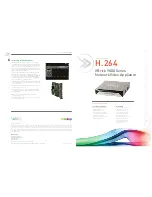
ProLine
™
�5���W�Power�Inverter�by�Wagan�Tech
®
www.wagan.com
13
©�����Wagan�Corporation.�All�Rights�Reserved.
Wagan�Tech�and�
wagan.com
�are�trademarks�used�by�Wagan�Corporation.
User’s�Manual—Read�before�using�this�equipment
14
��.� Turn�ON�the�inverter.�The�display�on�the�front�panel�should�show�between�
��.5�to��5�volts�depending�on�the�voltage�of�the�power�source.�When�the�
voltage�reading�does�not�fall�within�this�range,�check�the�connections�of�the�
wires�to�the�terminals�on�the�power�source�and�the�inverter�to�make�sure�
they�are�secure.�Also�check�the�voltage�of�the�power�source.�Make�certain�
that�the�High�Temp�or�Overload�LED�Indicators�are�not�lit.��
��.�Turn�OFF�the�inverter.�The�Overload�and�Over�Temp�LEDs�may�briefly�
“flash”.�This�is�normal.�The�audible�alarm�may�also�emit�a�short�“chirp”.�This�
is�also�normal.�
��.�When�you�have�confirmed�that�the�appliance�to�be�operated�is�turned�off,�
plug�the�appliance�into�one�of�the�AC�Outlets�on�the�front�panel�of�the�
inverter.�
�3.�Turn�the�inverter�on.�
Note:�If�an�extension�cord�is�used�from�the�inverter�to�an�appliance,�limit�the�
extension�cord�length�to�5��feet�or�less.�Make�sure�that�the�cord�is�properly�rated�
to�carry�the�appliance�load.�Extension�cords�are�not�to�be�used�as�permanent�
wiring.�Instead,�use�High�Output�Terminals�and�NEC�compliant�wiring,�outlets�and�
installation�techniques.
Charging�The�Battery�Bank
It�is�not�the�purpose�of�this�inverter�user’s�guide�to�provide�detailed�information�
regarding�battery�charging�systems.�However,�the�user�should�try�to�augment�any�
charging�system�with�either�wind�power�or�solar�power.�These�can�continue�to�
operate�during�power�outages�and�they�also�reduce�recharge�time.�If�automatic�
AC�powered�battery�chargers�do�not�provide�enough�charging�current�for�a�larger�
battery�bank,�is�permissible�to�have�two�automatic�battery�chargers�connected�to�
the�battery�bank.
REGULAR LOSS OF COMMERCIAL POWER
If�an�inverter�system�is�used�during�commercial�power�outages�that�occur�daily,�
configure�the�charging�system�to�replace�energy�during�the�time�that�commercial�
power�is�available.�Replacement�of�battery�energy�always�requires�more�than�was�
taken�from�the�battery�(typically��3��percent).�In�the�example�used�earlier�in�this�
document,�the�AC�load�ran�for����hours.�If�commercial�power�is�available,�there�
are�approximately��4�hours�left�in�the�day�to�do�the�recharging.�The�following�
is�an�example�of�what�is�necessary�to�recharge�a�battery�bank�that�has��6,5���
AH�of�capacity�(as�in�the�example�above)�and�has�been�discharged�to���.5�volts�
(discharged).�The�charger�has�to�replace���45�AH�(�65����.3�AH)�in��4�hours.�So�
the�charger�must�charge�at�a�rate�of��53�amps�for��4�hours.�As�this�charge�current�
is�distributed�among�the�batteries�in�the�battery�bank,�the�current�received�by�an�
individual�battery�is�within�its�charge�rating.�Be�sure�that�the�battery�is�well�vented�
as�the�area�will�likely�have�accumulations�of�an�explosive�mixture�of�hydrogen�
and�oxygen.�Follow�all�recommendations�for�use�that�are�contained�in�the�battery�
charger�manual.
WARNING
THERE IS DANGER OF EXPLOSION. DO NOT CONNECT OR DISCONNECT CHARGER
CABLES DIRECTLY AFTER BATTERY DISCHARGE OR RECHARGE–MAKE SURE THAT THE
BATTERY BANK AREA IS WELL VENTED BEFORE ATTACHING OR REMOVING CABLES.
If�the�flooded�lead�acid�batteries�are�used,�as�examples�given�in�this�document,�
be�sure�that�periodic�checks�of�battery�electrolyte�levels�are�accomplished.�Follow�
battery�manufacturer’s�instructions�in�keeping�the�electrolytes�at�the�proper�level.�Be�
sure�to�use�pure�distilled�water�when�replacing�evaporated�electrolyte�liquid.
ABOARD A VESSEL OR VEHICLE
Manufacturer�supplied�engine�driven�alternators�can�usually�be�replaced�with�ones�
that�can�continuously�deliver�higher�amperage.�This�should�be�done�at�the�outset.�
Keep�the�batteries�charging�when�the�vessel�or�vehicle�engine�is�operating.�In�
the�case�of�a�vessel,�make�sure�that�shore�power�is�used�to�recharge�the�batteries�
whenever�possible.
TELEVISION AND AUDIO SUGGESTIONS
Although�all�inverters�are�shielded�and�filtered�to�minimize�signal�interference,�some�
interference�with�your�television�picture�may�be�unavoidable,�especially�with�weak�
signals.�However,�here�are�some�suggestions�that�may�improve�reception.�
•� First,�make�sure�that�the�television�antenna�produces�a�clear�signal�under�
normal�operating�conditions�(i.e.,�at�home�plugged�into�a�standard�
��O/���V�AC�wall�outlet).�Also,�ensure�that�the�antenna�cable�is�properly�
shielded�and�of�good�quality.�
•� Change�positions�of�the�antenna�cable�and�television�power�cord.�
•� Isolate�the�television,�its�power�cord�and�antenna�cables�from�the����volt�
power�source�by�running�an�extension�cord�from�the�inverter�to�the�television�
set.�
•� Coil�the�television�power�cord�or�install�a�clamp-on�ferrite�choke�(available�
from�electronic�parts�suppliers).�
Note:�Some�inexpensive�audio�systems�may�have�a�slight�“buzzing”�sound�when�
operated�with�the�inverter.�This�is�caused�by�insufficient�filtering�in�the�audio�system.�
The�only�solution�to�this�problem�is�to�get�a�sound�system�with�a�higher�quality�
power�supply.�





























